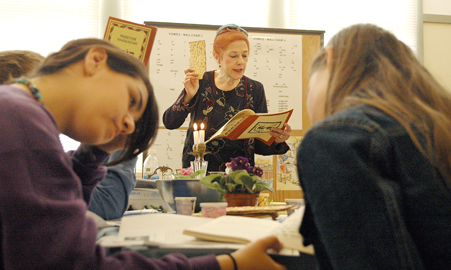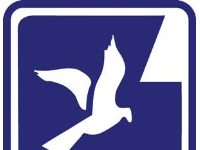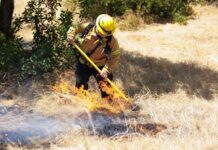
The ancient Jewish tradition lives on for the children of
Congregation Emeth
The children sat in chairs around two tables, working hard to
squelch their wiggles as they excitedly looked at all the items
spread out on the tablecloths in front of them. A calm voice drew
their attention to the head of one of the tables where a petite
woman wearing a shiny, emerald-colored yamaka smiled endearingly at
them. She was ready to initiate the first step of the ceremony. Two
candles were lit, a prayer was recited; the Passover Seder had
begun.
The ancient Jewish tradition lives on for the children of Congregation Emeth
The children sat in chairs around two tables, working hard to squelch their wiggles as they excitedly looked at all the items spread out on the tablecloths in front of them. A calm voice drew their attention to the head of one of the tables where a petite woman wearing a shiny, emerald-colored yamaka smiled endearingly at them. She was ready to initiate the first step of the ceremony. Two candles were lit, a prayer was recited; the Passover Seder had begun.
This past week, Jewish families throughout the world gathered together to participate in the centuries-old traditions of Passover, a holiday celebrating the release of their ancestors, the Israelites, from a life of slavery under the Egyptian Pharoah about 3,500 years ago.
A focal point of the eight-day holiday is the Seder (SAY-der), a dinner celebration taking place on the first two nights of Passover filled not only with food and wine, but ripe with symbolism, prayer and song.
For members of the Morgan Hill-based Congregation Emeth, this year’s Passover holiday also provided their children with a unique opportunity; the chance to participate in a special children’s Seder led by Cantor Hilda Abreyava. The celebratory meal held during last Sunday’s session of the Congregation’s religious school, gave children of all Jewish backgrounds a new experience. For those whose families might not celebrate Passover with a traditional Seder, the meal at the school introduced them to additional aspects of their faith. And for those coming from more orthodox families, the children’s Seder was a chance to gather around the table with their peers and mix some fun into the traditions.
“I really like the songs and the plagues,” said 10-year-old Zachary Jenkins, expressing a sentiment shared by several of the other children.
The “plagues” to which he referred represent the part of the Seder where participants take time to remember the story of the 10 plagues that God sent into Egypt to help convince the Pharaoh to free the Jews. This list, which includes natural disasters and terrible human and animal diseases, could normally be considered unpleasant to discuss, but with the right props and a corresponding kid-at-heart attitude, the educational activity became a fun way to release some energy. One girl tossed white foam balls, representing a plague of hail, across the table to her friend, who had donned a pair of bug-eyed sunglasses, representing a plague of insects. Nearby, another girl giggled as she popped bubble wrap, which represented a plague of boils, as a boy called out “RIB-bit, RIB-bit,” symbolizing a plague of frogs.
One of the most important components of the Seder meal is matzoh (MA-tzah), an unleavened cracker that, culturally, is likely the most recognizable part of the Passover holiday. The food, often eaten with butter or an apple-walnut-cinnamon mixture called haroset (ha-RO-set) represents the unleavened bread Jewish ancestors ate during their post-slavery exodus from Egypt. It is believed that the newly freed slaves fled Egypt so quickly they had no time to bake bread before leaving. The dough they packed with them baked quickly as they traveled under the hot desert sun, forming hard crackers. To commemorate this ancient event, Jewish families today eat matzoh instead of bread during Passover.
The Seder begins with the breaking of the matzoh. One portion of the broken matzoh is returned to the table, the other portion becomes the afikomen (a-fi-KO-mun), something to be wrapped in cloth and hidden for children to find towards the end of the meal. A special gift is typically given to the youngster who finds the concealed cracker.
Since tradition forbids eating anything containing leavening agents during the eight days of Passover, the symbolic matzoh cracker becomes an omnipresent aspect of the holiday. As an additional ritual, many families remove all items containing leavening agents from their households before the holiday begins. Some people, depending on how closely they adhere to traditional customs, will also empty their homes of anything considered non-kosher as well.
“In the home, if people are taking Passover seriously, they begin by cleaning the kitchen and the cupboards,” said Lana Olsson, a Congregation Emeth member.
But Olsson recognized that many families, especially in this region, are not looking to affiliate with a congregation that only tolerates strict adherence to orthodox Jewish traditions. Congregation Emeth, comprised of about 60 families, mostly from Hollister, Gilroy and Morgan Hill, has a nonexclusionary policy and welcomes Jewish and inter-faith families of varying levels of doctrine conformity. The 25-year-old congregation has never had a building of its own, and rents space at Carden Academy in Morgan Hill, as members work on plans for a permanent setting.
Judging from the smiles on everyone’s faces as they marched behind Cantor Abreyava last Sunday, singing and banging percussion instruments during a particularly festive part of the meal, the children’s Seder at Congregation Emeth was a hit. From learning how to make the tasty haroset to learning more of the prayers, every child walked away with a bit more Jewish tradition than they came with.
Olivia Pecot, 8, who has taken part in several Passover Seders with her family, took away some very specific information from this year’s celebration. When asked what she learned, she gave it a moment’s thought. Then, referring to the part of the Seder where everyone dips greens into saltwater representing the tears of the Jewish slaves, she declared what was now part of her Seder knowledge. “That you’re supposed to dip the parsley twice,” she said.






